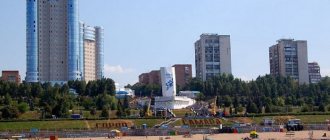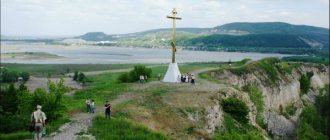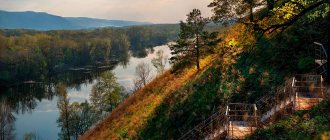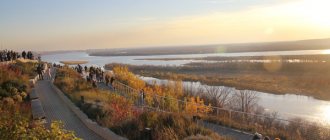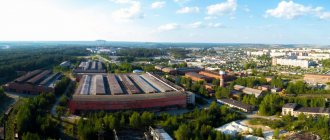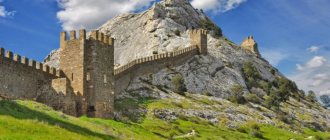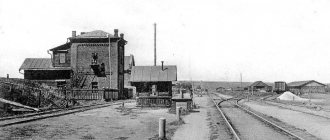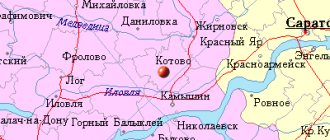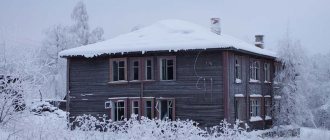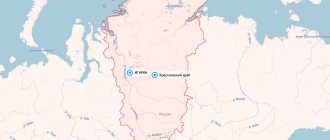When asked what Samara used to be called, many will answer “Kuibyshev” and they will be right. However, the city received this name at a time when many settlements in the country were renamed in honor of outstanding party members and revolutionaries, but its history began much earlier. She bore this name before, and the role she played in the life of Russia will be discussed in our article.
The first mentions of the Samara River and the city of the same name
The name of the city is directly related to the name of the Samara River, which is a tributary of the Volga. The first mention of it is found in the notes of the secretary of the Arab embassy Ibn Fadlan, who visited it in transit in May 922. He calls it the Samur River, referring to the name given to it by local nomads. However, the Arab diplomat does not mention any settlements.
Regarding what Samara was called before, that is, before it was officially fixed on the maps of Russia, researchers have a certain hypothesis, according to which its former name is consonant with the current one. This is evidenced, in particular, by the surviving Venetian map of 1367, which indicates a settlement called Samar in the Middle Volga region.
The settlement of the same name can be traced on another map, compiled in 1459 by the Catholic monk Fra Mauro, traveling along the Volga. However, there are skeptics who question the validity of identifying ancient Samara with the city that arose on the banks of the Volga in 1586.
Ethnic composition
The city borders in the southeast with the Orenburg Territory, in the west with the Saratov and Ulyanovsk territories, and in the north with the Republic of Tatarstan. Due to this proximity, a variety of nationalities live in the region.
The main nationalities living in Samara in 2020:
- Russian residents - 85.6%.
- Tatars – 4.1%.
- Chuvash – 2.7%.
- Mordva – 2.1%.
In Samara there are Orthodox, Catholic, Protestant churches, the Armenian Apostolic Church, mosques, a synagogue, and other religious buildings and centers.
A fortress built by the will of the king
It was in this year that the history of Samara began, founded on the banks of the river of the same name, not far from its confluence with the Volga. The time was extremely turbulent, and in order to protect the region from the constant raids of nomads, as well as to protect the watercourse from Kazan to Astrakhan from them, Tsar Fyodor Ioannovich ordered Prince G.O. Zasekin to build a fortress here.
The question of how Samara was formed has been considered by many generations of Russian historians. It turned out that by the will of the king, a small prison first appeared, which over time grew and turned into a fortress, which gave rise to a large city on the Volga. Its foundation and further construction are described in detail in the documents we received. They also contain the name of the city, which eliminates any doubt about the name of Samara previously.
The first inhabitants of the Samara town
According to historians, the Samara fortress, which has not survived to this day, was located in the part of the city where the reinforcement plant is located today. Although at that time they had no idea about shock construction, the ruler’s order was carried out without delay, and the fortress was built surprisingly quickly - in just three months.
The new city of Samara, still fragrant with fresh resin (as it was commonly called in the old days), was inhabited by military personnel: archers, artillerymen and “collar workers,” that is, those who had to guard the gates from any charming person. By decree of the Tsar, even boyar children were exiled here to serve the Motherland.
The history of Samara in the 17th century is a chronicle of tireless work to strengthen and expand it. As a result, in 1700 the city consisted of five defensive lines, including the Kremlin, two prison lines and the same number of nadolba lines, which were soon destroyed due to decay. However, this seemingly powerful outpost had a very significant drawback: all its buildings were wooden, which had the most devastating effect during the fires that engulfed the city in 1700 and 1703.
Forecast
What population size in Samara is expected in the future and how long the population decline in the region will last is unknown. It can be assumed that actions to improve the area will help, maybe not increase, but at least maintain the current indicators.
Measures taken by the government to increase the population:
- Forms a sustainable trend in the development of economic growth. In 2019, the region entered the top three district leaders in terms of average per capita industrial production, foreign trade turnover and average monthly wages.
- The government actively supports small and medium-sized businesses. First of all, support is aimed at maintaining population size. After all, the regional government is interested in the economic position of the city in the country.
- The country's two flagship universities are located in Samara and Tolyatti. Every academic season, universities attract many visiting students from neighboring communities. After completing their studies, students are offered promising jobs. Many of them remain to live where they studied. Since the number of budget places is growing every year, there is a high probability of increasing the population due to visiting students.
From watchtower to industrial giant
Following the guidance of bitter experience, the Samara people built a new, this time earthen fortress on the site of ancient ashes. During archaeological excavations carried out in 2013-2014, the remains of this structure were discovered in the Khlebnaya Square area.
In 1851, the Samara province was formed, and from that moment on, the city, which became its capital, received a powerful impetus for economic and cultural development. At the end of the 19th century, Samara was even called the “Russian Chicago” due to the rapid growth of industrial production and trade. The city, which in those years numbered fifteen thousand inhabitants, was replete with various enterprises, warehouses and steam mills.
It is interesting that it was here that for the first time in Russia the horse-drawn tram was replaced by a tram, which left the city depot in 1915. As newspapers of the time noted, it was entirely assembled from domestic parts and materials. Samara is also the birthplace of our favorite beer, Zhigulevsky, the production of which began in 1881 at the plant of the Austrian entrepreneur Alfred von Vacano. By the way, at first it was called “Vienna”, but then it received a more patriotic name.
Current data
36 percent of the population of the entire region lives in the territory of the most populous city. The population of Samara is 1,156,659 people. City assessment for 2022:
- Samara took 8th place in the list of large million-plus cities in Russia.
- The city and its surroundings occupy 11th place in the ranking of densely populated regions of the Russian Federation.
- At the end of 2022, Samara took 6th place in the rating of constituent entities of the Russian Federation in terms of the level of development of labor potential and 13th place in Russia in terms of investment potential.
- Samara is a highly urbanized region - 79.8% of citizens of the total population live in urban areas.
- The share of the province's foreign trade turnover in the foreign trade of the Volga Federal District was 12.9%.
- Samara's trading partners are 134 foreign countries.
- There are 700 large and medium-sized industrial enterprises operating on the territory. Based on the results of work in 2022 and the beginning of 2022, Samara took 4th place in the Volga Federal District in terms of the volume of shipped industrial goods.
Second capital of the country
The city played an important role in the life of the country during the Great Patriotic War. In essence, it served as the second capital of the Soviet Union. The government and some foreign diplomatic missions moved here to the banks of the Volga.
In case of an emergency, the city was ready to become the headquarters of the Supreme Commander-in-Chief I.V. Stalin. A residence was built for him, equipped with an underground bunker. Today it is part of the city museum and can be visited.
Samara
Samara is a city where you can spend equally rich time walking the streets or visiting museums. Add to your excursion program a visit to one of the theaters, a river walk along the Volga or a trip outside the city - and Samara will certainly enchant you. Top 10 things to do in Samara to discover the city from different sides:
Sculpture “Rook”
© Larisa Kiseleva
Walk along the Volga embankment . Samara embankment is the longest in the Volga region. The landscaped area stretches for 5 km. You can sit meditatively on the shore or go for a river walk.- Take a ride along the Volga . In the summer, it is worth going for a walk along the watery expanses of the Volga on a river bus or motor ship, and in the winter - on a hovercraft.
- Meet the sunrise in a helicopter . The most beautiful observation deck is located on the outskirts of the city. It offers panoramic views of the Samara Luka and the Volga. You can also go up to the observation deck of the railway station or under the business dome.
- Try Zhigulevskoe beer . It is best to go on excursions to the ancient Zhigulevsky brewery. During the tour, you will see the enterprise from the inside and will be able to taste the freshest Zhiguli beer.
- Explore the houses of Samara Art Nouveau . The popular architectural style of the early 20th century is very widely and variedly represented in Samara. Discover the "house of elephants" and the whimsical mansion of Dr. Erich Ern.
- Go down to Stalin's bunker . At a depth of 37 meters is located one of the most secret objects of the USSR. Now the bunker houses a museum dedicated to the Great Patriotic War.
- Try Volga crayfish . Boiled crayfish are a gastronomic specialty of the Volga cities. You can buy crayfish at the market and try to cook them yourself, or you can send them to a crayfish shop, where you will be served a dish of crayfish seasoned with aromatic herbs and sauces.
- Take a photo with a real rocket . The façade of the museum and exhibition is decorated with a real Soyuz launch vehicle, manufactured at the Progress plant in Samara.
Guide
A walking route around Samara can be either an introduction to the main attractions of the city or a thematic one. In Samara, there are excursion routes for those interested in astronautics or the Art Nouveau architectural style, as well as walks to places of different historical periods.
Route 1: Samara classic
An introductory route to the sights of the historical center of Samara begins on Kuibyshev Square. This is one of the largest squares in Europe. On the square it is worth visiting the building of the Samara Opera and Ballet Theater and the sculptural composition “Architecture of Dance”. Further along the route:
- Tolstoy House Museum
© Larisa Kiseleva
Stalin's bunker . Between Kuibyshev and Chapaev squares on Shostakovich Street there is one of the most unusual museums in Samara. At a depth of 37 meters, Stalin’s bunker with a recreated wartime environment has been preserved. - Museum of Art Nouveau . Turn onto Frunze Street, at the intersection with Krasnoarmeyskaya Street there is a Museum of Art Nouveau - the only one in Russia dedicated to the Art Nouveau style.
- Church of the Sacred Heart of Jesus . A Catholic church in the neo-Gothic style was erected in Samara at the beginning of the 20th century. The temple is active, tourists can explore it outside and inside.
- Museums of Frunze Street . On the street there is the museum-estate of Alexei Tolstoy and the museum of Eldar Ryazanov.
- Pedestrian street Leningradskaya . On Samara Arbat you can take funny pictures with street sculptures, have a snack in one of the cafes, or just relax on a bench.
- Samara embankment . Along Leningradskaya Street go down to the banks of the Volga. The famous sculptures “Barge Haulers on the Volga” and “Comrade Sukhov” are installed on the embankment. The total length of the embankment is 5 km.
- Strukovsky garden . The embankment gradually turns into one of the oldest park areas in Samara - the cozy and green Strukovsky Garden.
- Zhigulevsky brewery . Having walked through the Strukovsky Garden and examined the gingerbread-looking building of the Drama Theater named after. Gorky, move along Volzhsky Prospekt to the brewery. The brick building, built in tsarist times, is remarkable both externally and internally. The brewery is still operating - tourists are offered excursions with tasting of the famous Zhigulevsky beer.
Here you can go to the Volga along the Ulyanovsky descent, go on a pleasure boat to the village of Rozhdestveno and take a walk through the Samarskaya Luka National Park. Another option: end the day on the new Samara embankment. Here you can watch a show of singing fountains, take a photo with the snow-white “Rook” and watch the sunset over the Volga.
Route 2: Samara Modern
The excursion to see the masterpieces of Samara architecture also starts from Kuibyshev Square. The first house is located at Chapaevskaya Street, 165, a short walk from the square. This is the mansion of Dr. Ern, supposedly the first building in the Art Nouveau style in Samara. Next door, at 159 Frunze Street, there is Kurlina’s mansion with a mysterious female profile on the pediment. Nowadays there is a Museum of Art Nouveau inside Kurlina’s mansion. On Frunze, 141, there was formerly the building of the Olympus circus theater, which is now occupied by the Samara Philharmonic. On Frunze, 144 there is a more sophisticated example of the so-called “elite” modernism - the Novokreshchenova mansion. The building stands out for its decor with floral motifs.
House in the Northern Art Nouveau style on Kuibysheva Street
© Larisa Kiseleva
Turning from Frunze onto Kuibysheva Street, move to house No. 111. Here is the Bristol-Zhiguli Hotel, built in 1879 and, a little later, reconstructed in the Art Nouveau style. The façade and interiors of the hotel are decorated with orchids. At Kuibysheva, 93 there is a building of the former bank of the mutual credit society in the late modern style.
On Lev Tolstoy Street, noteworthy is house No. 94, once the Pushkin People's House. This is a rare example of a public building in the Art Nouveau style. On Tolstoy, 41 there is the Suroshnikov mansion, a representative of the “northern” Art Nouveau style.
On Leningradskaya Street, the Golovkin apartment building (house No. 44) with forged balcony railings and an abundance of decorative elements is especially interesting. At 55 Ventsek Street, the Shikhobalov mansion with a beautiful facade decorated with pediments and flowerpots has been preserved.
On Samarskaya Street, pay attention to houses No. 149 and No. 179. The first is Nuychev’s apartment building with elegant zoomorphic ornaments. The second is Zelenko’s mansion with interesting windows of different sizes. On Samarskaya, 95 there is the building of the pre-revolutionary restaurant “Aquarium”. The building is one of the most striking examples of strict and rational modernism. On Sadovaya, 231, the building of the Furor cinema has been preserved, richly decorated with stucco.
The last house on the route is located at a distance from the others. This is the famous “House with Elephants” at the address: Sovetskaya Armii Street, 298. The former dacha of the artist, traveler and self-taught architect Konstantin Golovkin was designed by the owner himself. The building is notable for the elephant sculptures installed on both sides of the façade.
In detail: What to see in Samara in a day
Event tourism
Samara is deservedly considered one of the cultural centers of the Volga region. The city and the Samara region host many festivals of different genres - from music and theater to sports. What cultural events in Samara and the Samara region should every traveler visit?
The Volga Quest sled dog race takes place on the territory of the Samarskaya Luka National Park. The total length of the route is 250 km. The festival is held in the first half of February. A festive program will be organized for festival guests - on the opening day and on the closing day of the races.
Stage for summer festivals
© Larisa Kiseleva
The winter festival of active recreation “Zhigulevskoe Sea” is dedicated to snow kiting. The festival takes place in the waters near Togliatti: freeriders perform breathtaking stunts, kites are launched into the sky, and races are organized for amateurs, not professionals.
Jazz Spring in Samara is an international festival that has been taking place in the city for more than 10 years. For three days in early March, concerts of famous jazz bands and solo performers are held at various venues in the city.
The international festival “Drums of the World” takes place at the Kuprinka recreation center in the village of Pribrezhny. For three days you can listen to masters of the drum genre from all over the world, attend their master classes and an ethnic goods fair.
The Volgafest embankment festival takes place in Samara over two days in mid-June. Against the backdrop of the Volga sunsets, theatrical and musical performances, performances and public art programs take place.
The Rock over the Volga festival is the main musical event in the Samara region. This is Europe's largest one-day festival. The maximum number of spectators was almost 700 thousand people. During the day, almost all famous rock performers and groups of Russia, as well as foreign guests, perform on the festival stage.
The All-Russian Festival of Brass Bands “On the Hills of Manchuria” is held in the open air at the end of June. Orchestras perform in parks, on the embankment and in the amphitheater of Glory Square. Guests can dance classical dances to classical music in the solemn atmosphere of past centuries.
The Grushinsky Bard Song Festival takes place in a picturesque place - on the Mastryukov Lakes. For 4 days in early July, soulful original songs will be performed on a floating stage and around bonfires.
Flower Festival
© Victoria Sarkisova
The international festival of street theaters and contemporary art “Plasticine Rain” is held in the Strukovy Garden of Samara in the second half of August. Theaters from different cities, musical groups and artisans will perform at several venues. A separate area is organized for children's entertainment. At the restaurant alley you can try dishes from local chefs, and at the fair you can buy handmade products from festival artisans.
The gastronomic festival “Zhigulevskaya Cherry” is considered one of the largest in Russia. It is held annually in the village of Shiryaevo. The highlight of the festival is the preparation of a multi-meter cherry pie, which everyone can try. The festival program includes culinary competitions, competitions for the best cherry costume, and a craft fair. Carousels and slides are installed for children.
The Shiryaevo Biennale of Contemporary Art is held in August in the village of Shiryaevo. Works of contemporary art are exhibited against the backdrop of nature and rural landscapes: the Volga, adits, village houses and surrounding mountains. The main event of the biennale is the nomadic show: a procession during which guests can get acquainted with all the art objects. This is the only village biennale in the world.
Seasonal holidays
When is the best time to go to Samara? The city is interesting at any time of the year. In winter, Samara is a charming town covered in snow. During this period, it is so pleasant to combine short walks along the city streets with cozy gatherings in a cafe. During the warm season, Samara hosts many festivals, from contemporary art to classical music. In summer, excursion walks around Samara can be combined with trips to nature. And in the fall - enjoy the quiet poetry of nature.
Winter
Kuibyshev Square
© Yulia Kuznetsova
In winter, travelers prefer to visit Samara during the New Year holidays. The main Christmas tree of Samara is installed on Kuibyshev Square. Here, on a huge area, 2 skating rinks are poured, a wooden slide is installed and an ice sculpture garden is built. A New Year's fair is organized on Kuibyshev Square for the entire holiday period, and horseback riding and children's train rides are offered.
Open-air skating rinks are installed at the Solidarity Arena stadium, in Gagarin Park with a heated gazebo, on Glory Square, and in Friendship Park. The longest skating rink in Samara is the ice track on the embankment. It stretches from the CSKA swimming pool to Mayakovsky Spusk.
The ski season in Samara begins in late November - early December. The ski season lasts until the end of March - beginning of April. Not far from the center of Samara there is the SOK ski resort (in the village of Krasnaya Glinka). The resort's 8 pistes are served by 7 ski lifts. The longest route is 1200 meters long. You can practice performing difficult tricks in the snow park. The Slope Sports and Recreation Center is located near the village of Malaya Tsarevshchina, also close to Samara. There are 2 fairly easy trails for visitors. "Slope" is especially popular for family holidays. The favorite place of freeriders is the Avalman ski complex. There is no artificial snowmaking or snow-compacting equipment at the resort; freeriders appreciate the uneven terrain and use it to perform tricks.
Spring
A sunny and blooming spring begins in Samara closer to May. During the May holidays, the number of tourists in the city increases noticeably. Travelers arrive in the city mainly on cruise ships. In May, in Samara you should take a leisurely stroll along the embankments and parks, enjoying the long daylight hours and mild weather. The festival season also begins in the spring. It is worth visiting the international jazz festival, which is held in early spring, or Samara Mayovka, a motorcycle festival.
Summer
Summer time in Samara is the time for river walks along the Volga, open-air music festivals and trips outside the city. You can go on a river walk from one of the piers on the long embankment of Samara. The navigation period along the Volga begins in May and lasts until October. The most popular river walk routes: to the village of Rozhdestveno and the Samarskaya Luka National Park; to the village of Shiryaevo - the place where Repin made sketches for the painting “Barge Haulers on the Volga”; to Vinovka with the Holy Mother of God Kazan Monastery.
Central Beach
© Larisa Kiseleva
The swimming season on the Volga begins in the second half of June and lasts until mid-August (in some places until the end of August). Samara beaches are considered the best on the Volga. The central beach of Samara is located near the embankment. This is a landscaped area with sun loungers and umbrellas, sports and children's playgrounds, locker rooms and sanitary facilities. The central beach is sandy and wide, entry into the water is along the sand.
On the opposite shore, on Podzhabny Island, there are the Sredny and Nizhny beaches. These are less refined places, with a free atmosphere and the absence of crowds of vacationers. The beaches can be reached by river transport. There are also uncrowded sandy beaches on Zelenenky Island. The island is often visited by tourists with tents - on weekends or during vacations. Families with children often come to Krasnoglinsky Beach - the beach has a comfortable gentle slope with a sandy bottom. You can also go on vacation to the lakes of the Samara region: Alekseevsky and Chkalovsky quarries, Mastryukovsky lakes.
A popular place among hikers in the Samara region is the Samarskaya Luka National Park with the picturesque Zhiguli Mountains. The Samarskaya Luka National Park has hiking trails for hikers and cyclists. There are special routes for horseback riding. Rafting in the Samara region takes place both along the Volga itself and along small rivers: Bolshoy Cheremshan, Sok, Samara.
Autumn
The beginning of autumn in Samara is a mild, warm time, which is equally suitable for hiking and walking around the city. In September, the festival season ends in the city: it is worth visiting the music festival “For Mstislav Rostropovich” or the bike-rock festival “Listopad”. Navigation along the Volga continues until October - in September both large cruise ships and pleasure river trams operate. Since October it has become significantly colder in Samara, and the number of tourists is declining. Late autumn in Samara and the region is not a very popular period among tourists. At this time, travelers more actively visit museums and numerous theaters in Samara.
In detail: What to see in Samara in summer
Party places
The most popular dance clubs in Samara are “Lust”, “Aura” with two dance floors and “Hands Up”. The latter establishment is famous for parties in the style of the 80s and 90s. At the Ruki Vverh club you can not only dance to your favorite hits, but also sit quietly at a table or visit the karaoke room. The Zvezda club is the most popular concert venue. Zvezda often hosts concerts of local performers and groups from other Russian cities. The Metelitsa club with several halls will appeal to those who are nostalgic for the club atmosphere of the 2000s. Rock bar “Basement” is a place with the atmosphere of semi-legal bars of past decades. People come here to listen to Samara rock performers. It's a fun and loud bar with inexpensive drinks and alternative concerts.
Bar "At the bottom"
© Larisa Kiseleva
Idol is considered the best cocktail bar in the city. A special feature of the establishment is tropical tiki cocktails. The Idol bar is also famous for its Indian-American cuisine. On Fridays and Saturdays, “Idol” hosts musical evenings. The “Na Dnenie” bar is worth a visit to try the beer that comes to the bar directly through a pipe from the brewery. The underground bar “Come what may” is the most fashionable place among young people. On Fridays and Saturdays, “Come what may” hosts the most exciting parties in the city. The Borya glasshouse is one of the most atmospheric places that serves excellent Zhigulevskoe, signature liqueurs and original Russian-style snacks.
The top place for informal youth is the art cluster “House 77”. On the ground floor of the building on Leningradskaya Street there is a fashionable bar “Forever Young” with a summer terrace where hundreds of people gather. The remaining floors house rehearsal rooms for local musicians, craft workshops, dance and photography studios, and vintage fairs. At Novo-Sadovaya, 149, in the building of the former “Factory-Kitchen”, a branch of the Tretyakov Gallery and a public space will soon open.
Vacation with children
Drama Theater named after Gorky
© Larisa Kiseleva
Samara often leads in ratings of the best cities for traveling with a child. The city on the Volga has a large selection of activities for children of all ages. Samara’s special pride is museums for children. Thus, in the ancient mansion of the merchant Klodt of the late 19th century, a Children's Art Gallery was opened. The gallery's exhibition is divided into 4 parts: a museum of children's creativity, a museum of everyday life and culture of the late 19th - early 20th centuries, a museum of decorative and applied arts and a winter garden. The Samara Children's Gallery regularly hosts creative master classes for children. The Alexei Tolstoy Museum is located in the only surviving wooden estate. Inside the estate there is an interactive space based on the fairy tale “The Golden Key, or the Adventures of Pinocchio.” During the quest, the children will escape from Karabas-Barabas, find the golden key and take part in a theatrical production.
You can join the cultural life of Samara in one of the city’s theaters. With children, first of all, you should go to the Samara Puppet Theater. The theater's repertoire includes more than 40 productions based on children's works and fairy tales: “Mashenka and the Bear”, “Baby and Carlson”, “The Night Before Christmas”. SamArt's repertoire includes productions for schoolchildren based on the classic works of Pushkin, Turgenev, and Ostrovsky. There are also children's productions at the Samara Opera and Ballet Theater: “The Bremen Town Musicians”, “Aladdin’s Magic Lamp”, “The Story of Kai and Gerda”. With kids it is worth visiting the Fairytale House museum-theater.
© Tatiana Dudarenko
Samara Zoo is small, but cozy and clean. Once a week, the zoo hosts walks with tame animals. Thematic excursions dedicated to different types of animals are organized for children. You can get acquainted with the inhabitants of the underwater world in the new oceanarium with the longest aquarium in Europe (50 meters). In the aquarium you can see not only sharks, rays, moray eels, exotic fish, but also crocodiles and turtles. Next to the oceanarium is the Victoria water park - its territory is designed in the form of an exotic island.
For active entertainment, head to the Country Park. There are attractions of varying levels of extremes for children and adults, a rope park and a Tarzania climbing wall, inflatable slides and trampolines, and, in the winter months, a tubing slide. In the park named after Gagarin there is an amusement park "Three Bears". You can immerse yourself in the atmosphere of the Wild West at the Western Park amusement park.
Detailed material: Samara for children
City during the war years
In addition to government institutions, the city had many enterprises evacuated from the western regions of the country, as a result of which the level of industrial production in it increased fivefold during the war years. To provide the front with combat aviation, a powerful aviation complex was formed in the city, which established the production of world-famous aircraft such as Il-2 attack aircraft and MiG-3 fighters.
The Bolshoi Theater in Moscow was located and continued to operate here. An important event in the cultural life of Kuibyshev during the war years was the performance in its hall of the Seventh Leningrad Symphony, which was performed by D. D. Sostakovich, who was evacuated here. The city's embankment became a kind of war monument, covering which granite was used, once stolen from defeated Germany.
The flag of Samara, which has become a symbol of new times
Throughout the entire period of communist rule, before the start of perestroika, party ideologists tried in every possible way to destroy people’s memories of what used to be called Samara. The same trend is observed in other renamed cities of the country.
However, already in 1990, at the very beginning of the democratic transformations that swept the country, the city was returned to its historical name, and eight years later, by decision of the City Duma, the flag of Samara was approved. It would not be an exaggeration to say that for the townspeople it became not only the official symbol of the municipality, but also the visible embodiment of the changes brought by perestroika in the life of every citizen of Russia.
